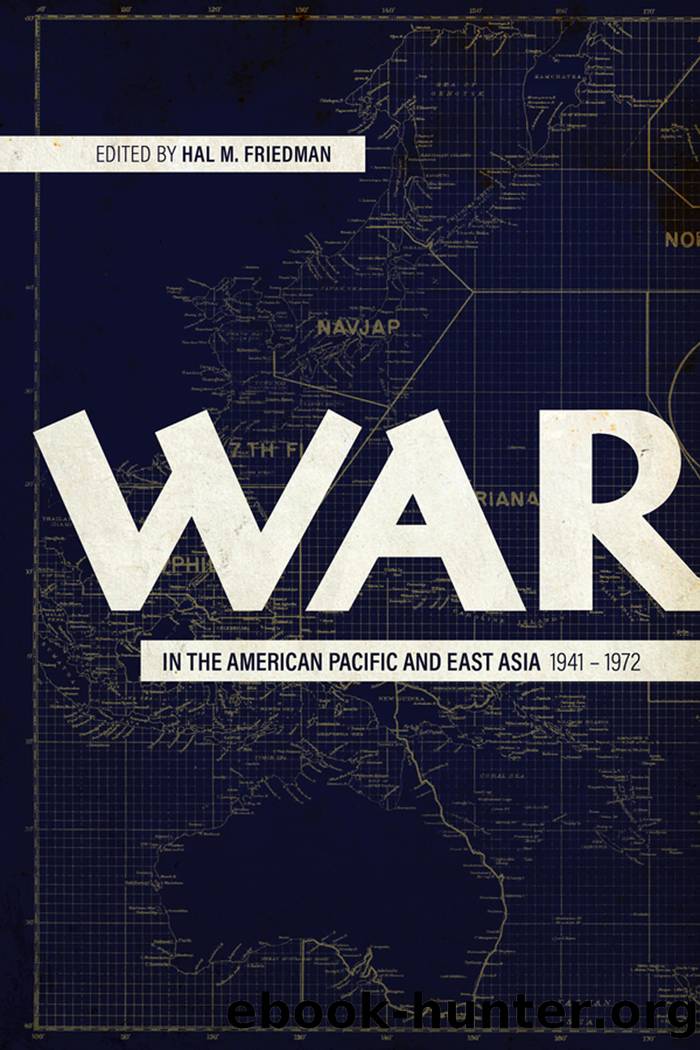War in the American Pacific and East Asia, 1941-1972 by Unknown

Author:Unknown
Language: eng
Format: epub
Publisher: University Press of Kentucky
Published: 2018-07-14T16:00:00+00:00
5
Arguing over A-Bombs
Interservice Rivalry and the Atomic Bomb Tests at Bikini Atoll, September 1945–June 1947
Hal M. Friedman
Between 1945 and 1947, the United States sought an imperial solution to its security problems in the Pacific Basin. Faced with fears of a future Pearl Harbor–style attack by a potentially resurgent Japan, and facing an even more realistic confrontation with the Soviet Union, American policymakers, planners, and strategic thinkers saw the creation of an “American lake” in the postwar Pacific as the best means by which to guarantee U.S. security interests vis-à-vis East Asia. In particular, they saw a need to blanket the Pacific with mobile American military force, as well as fortified bases at selected sites, while attempting to Americanize Micronesia and as many other areas of the region as possible. The problem with creating an American lake in the postwar Pacific, however, had to do with differences of opinion among the Executive Branch Departments that had responsibilities in the area. The War, Navy, State, and Interior Departments all agreed with one another, as well as with the Office of the President and Congress, on the efficacy of creating an American lake in the postwar Pacific Basin. However, these departments and agencies all disagreed, often vehemently, with one another on how to carry out these national security measures. So, while the final goal of creating an American lake in the postwar Pacific was a rough strategic consensus between these Executive Branch Departments, the means by which to carry out the Americanization and defense of the region led to significant interdepartmental and sometimes even intradepartmental bickering and rivalry. As will be seen, one of the primary arenas for the interservice rivalry between the Army and the Navy was the atomic bomb tests carried out at Bikini Atoll in the Marshall Islands in July 1946.
The Context
Interservice rivalry had been a reality of American defense policymaking since the earliest days of military aviation. Before that, there had been informal agreements between the Army and Navy about the division of defense responsibilities. Before the invention of the airplane, for instance, it had been largely understood that the Navy was responsible for defending American interests on the high seas and that the Army was primarily responsible for the defense of the nation itself and its overseas territories.1 The development of military aviation in the early twentieth century, however, changed this situation. In fact, it can be said that since the 1920s, interservice debates on the roles and missions revolving around the military use of the airplane had become a staple of American defense policymaking. In essence, the potential of the airplane as a military weapon largely dissolved the neat line separating roles and missions and cast doubt on the Navy’s ability to continue as the nation’s first line of defense.2 That neat line was further dissolved in the early 1920s when forces under Brigadier General William Mitchell, Assistant Chief, U.S. Army Air Service (AAS), carried out aerial bombing experiments against old U.S. Navy and ex–Imperial German Navy battleships off the Virginia Capes.
Download
This site does not store any files on its server. We only index and link to content provided by other sites. Please contact the content providers to delete copyright contents if any and email us, we'll remove relevant links or contents immediately.
| Africa | Americas |
| Arctic & Antarctica | Asia |
| Australia & Oceania | Europe |
| Middle East | Russia |
| United States | World |
| Ancient Civilizations | Military |
| Historical Study & Educational Resources |
Cat's cradle by Kurt Vonnegut(15112)
Pimp by Iceberg Slim(14233)
4 3 2 1: A Novel by Paul Auster(12233)
Underground: A Human History of the Worlds Beneath Our Feet by Will Hunt(11986)
The Radium Girls by Kate Moore(11877)
Wiseguy by Nicholas Pileggi(5618)
Perfect Rhythm by Jae(5282)
American History Stories, Volume III (Yesterday's Classics) by Pratt Mara L(5217)
The Fire Next Time by James Baldwin(5206)
Paper Towns by Green John(5030)
Pale Blue Dot by Carl Sagan(4867)
A Higher Loyalty: Truth, Lies, and Leadership by James Comey(4803)
The Mayflower and the Pilgrims' New World by Nathaniel Philbrick(4383)
The Doomsday Machine by Daniel Ellsberg(4380)
Killers of the Flower Moon: The Osage Murders and the Birth of the FBI by David Grann(4353)
The Sympathizer by Viet Thanh Nguyen(4267)
Too Much and Not the Mood by Durga Chew-Bose(4237)
The Borden Murders by Sarah Miller(4196)
Sticky Fingers by Joe Hagan(4071)
